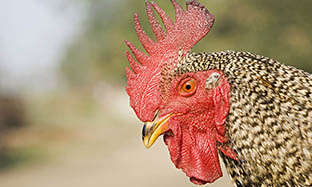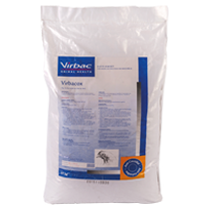
Coccidiosis in Poultry
For many years, coccidiosis has been a major cause of poor performance and lost productivity in poultry and other farm animals due to the damage caused in the intestinal tract. The disease is caused by protozoan parasites of the genus Eimeria, the oocysts of which can be present in the environment wherever poultry are raised. The life cycle is direct and involves oral ingestion of the infective sporulated oocyst, asexual and sexual reproduction in the host, and completion of a new generation of oocysts 4 - 7 days later. Each species is specific to a given host and those that parasitize poultry are not capable of establishing infection in other hosts such as cattle and sheep.
Early recommendations for controlling coccidiosis involved attention to improvements in management and hygiene. Although this is still important, the intensive nature of the poultry industry, the fact that birds are usually reared in direct contact with their faeces, and the resilience of oocysts ensures the continued presence of coccidia wherever poultry are raised. Attempts to eradicate the disease have been unsuccessful.
This situation was transformed in the 1940s by the discovery of chemical products that could be incorporated in the feed of poultry to prevent coccidiosis. Prevention (prophylaxis) has been the mainstay of poultry-meat production ever since. The Achilles’ heel of chemotherapy has always been the acquisition of drug resistance by parasites. Chemical anticoccidials include actives like nicarbazin, robenidine, clopidol & diclazuril.
In the 1960s, monensin was described and this ionophore compound was reported to have broad-spectrum anticoccidial activity. This discovery led to the introduction of further ionophore compounds (salinomycin, lasalocid, narasin & semduramycin) with a similar mode of action. Iononophores have been in use for many years because the development of resistance has proved to be very slow & ionophores prevent the clinical effects of coccidiosis, while allowing birds to acquire natural immunity to infections.
Today, alternatives to in-feed medication exist, namely live vaccines against coccidiosis. Vaccines can be used in broilers and breeder birds and are usually applied at day-old in the hatchery by spray or eye drop.
Signs of coccidiosis range from a decrease in growth rate to a high percentage of visibly sick birds, severe diarrhoea, and high mortality. Feed and water consumption are depressed, causing weight loss, development of cull birds & a decrease in egg production. Mild infections of the intestine (subclinical) may lead to secondary infection, particularly with Clostridium spp. that can result in necrotic enteritis. Survivors of severe infections recover in 10–14 days, but may never recover lost performance. The lesions are almost entirely in the intestinal tract and often have a distinctive location and appearance that is useful in diagnosis.
Eimeria tenella occurring in the caeca & E.necatrix in the mid small intestine are the most pathogenic and responsible for most deaths due to coccidiosis. E.acervulina in the upper small intestine and E.maxima in the mid small intestine can result in production losses.
Eimeria acervalina occurring in the upper small intestine (duodenum)
Eimeria tenella occurring in the caeca
Necropsy of several fresh specimens is advisable. Classic lesions of E.tenella & E.necatrix are pathognomonic, but infections of other species are more difficult to diagnose. Comparison of lesions and other signs with diagnostic charts allows a reasonably accurate differentiation of the coccidial species. Coccidial infections are readily confirmed by demonstration of oocysts in faeces or intestinal scraping using a microscope. Mixed coccidial infections are common.
Although a producer may depend on management & prevention, drugs are useful for rescue treatment in the case of an outbreak. There is no need to destroy infected birds, they can be treated. Drugs like sulphonamides, amprolium & toltrazuril can be used in the drinking water to treat coccidiosis.


